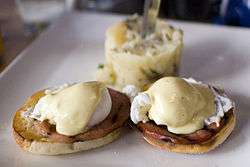Poached egg

A poached egg is an egg that has been cooked by poaching, as opposed to simmering or boiling liquid. This method of preparation is favored for delicate foods that could be damaged by cooking at higher temperatures such as the boiling point of water.
Preparation

The egg is cracked into a cup or bowl of any size, and then gently slid into a pan of water at approximately 75 Celsius and cooked until the egg white has mostly solidified, but the yolk remains soft. The 'perfect' poached egg has a runny yolk, with a hardening crust and no raw white remaining.[1]
Eggs for poaching should be fresh, although newly laid eggs need to be more than 12 hours old; otherwise the white will separate from the yolk.[2] Broken into water at the poaching temperature, the white will cling to the yolk, resulting in cooked egg white and runny yolk.
To prevent dispersion of the white of the egg, it can be strained beforehand, removing the parts of the white that are likely to disperse and creating a perfect, compact poached egg every time, with very little effort and without resorting to other risky methods such as vinegar.[3]
Another method states that a small amount of vinegar may be added to the water.[4] However, this technique is risky, as one may add too much vinegar into the water, resulting in a dry egg and an acidic taste. Stirring the water vigorously to create a vortex may also reduce dispersion.[5]
Special pans, with several small cups, allow a number of eggs to be poached at the same time. These were a popular utensil for many years but the resultant rubbery texture and "bun-shaped" eggs they produced saw their popularity fade as TV shows and books - especially those on traditional French cooking as exemplified by Julia Child and Elizabeth David - revived interest in basic domestic cookery techniques. Other methods of producing poached eggs, such as using cling film to keep the egg perfectly formed have been documented.[6]
Cooking time varies from about two and a half minutes if the eggs begin at room temperature, about three minutes if taken from a refrigerator. The exact time depends on the size of the egg, and other factors such as the design of the poaching apparatus. Dipping the eggs into cold water for a few seconds immediately after taking them out of the boiling water helps prevent over-cooking.
The traditional method of poaching eggs is on the stove top.[7] Another method uses a microwave.[8]
Steamed
The term "poaching" is used for this method but is actually incorrect. The egg is placed in a cup and suspended over simmering water, using a special pan called an "egg-poacher". This is usually a wide-bottomed pan with an inner lid, with holes containing a number of circular cups that each hold one egg, with an additional lid over the top. To cook, the pan is filled with water and brought to a simmer, or a gentle boil. The outer lid holds in the steam, ensuring that the heat surrounds the egg completely. The cups are often lubricated with butter in order to effect easy removal of the cooked egg, although non-stick egg poachers are also available.
The result is very similar to the traditional coddled egg, although these steamed eggs are often cooked for longer, and hence are firmer. Eggs so prepared are often served on buttered toast.
Dishes with poached eggs

Poached eggs are used in the traditional American breakfast/brunch dishes Eggs Benedict and Eggs Florentine.
Poached eggs are the basis for many dishes in Louisiana Creole cuisine, such as Eggs Sardou, Eggs Portuguese, Eggs Hussarde and Eggs St. Charles. Creole poached egg dishes are typically served for brunches.[9]
Several cuisines include eggs poached in soup or broth and served in the soup. In parts of central Colombia, for instance, a popular breakfast item is eggs poached in a scallion/coriander broth with milk, known as changua or simply caldo de huevo ("egg soup").
The Libyan dish Shakshouka consists of eggs poached in a spicy tomato sauce.
In Italy poached eggs are typically seasoned with grated parmigiano reggiano and butter (or olive oil).
Turkish dish Çılbır consists of poached eggs, yogurt sauce with garlic and butter with red peppers.
In India, fried eggs are most commonly called "poached," but are sometimes also known as bullseyes, as a reference to "bullseye" targets, or "half-boil" in Southern India, indicating that they are partly cooked. These eggs are "poached" in name only and so do not share the same preparation method as poached eggs in other countries.
See also
References
- ↑ www.perfectpoachedegg.com. "What makes a perfect poached egg?". Retrieved 2008-07-26.
- ↑ www.whatscookingamerica.net. "Perfect Poached Eggs – How To Poach Eggs". Retrieved 2008-07-26.
- ↑ "How to Poach Eggs, the Foolproof Method (Really!)".
- ↑ "everybody likes sandwiches: how to make the perfect poached egg". Retrieved 2009-08-02.
- ↑ "how to poach an egg, smitten kitchen-style". smitten kitchen. Retrieved 2009-08-02.
- ↑ www.b3ta.com. "FEATURES: HOW TO POACH AN EGG". Retrieved 2008-07-26.
- ↑ www.poachanegg.com. "HOW TO POACH AN EGG: poaching an egg". Retrieved 2016-07-23.
- ↑ www.poachanegg.com. "MICROWAVED POACHED EGG:". Retrieved 2016-07-23.
- ↑ John D. Folse, The Encyclopedia of Cajun & Creole Cuisine, Chef John Folse & Company Publishing, December 2004, ISBN 0-9704457-1-7
External links
| Wikibooks Cookbook has a recipe/module on |
